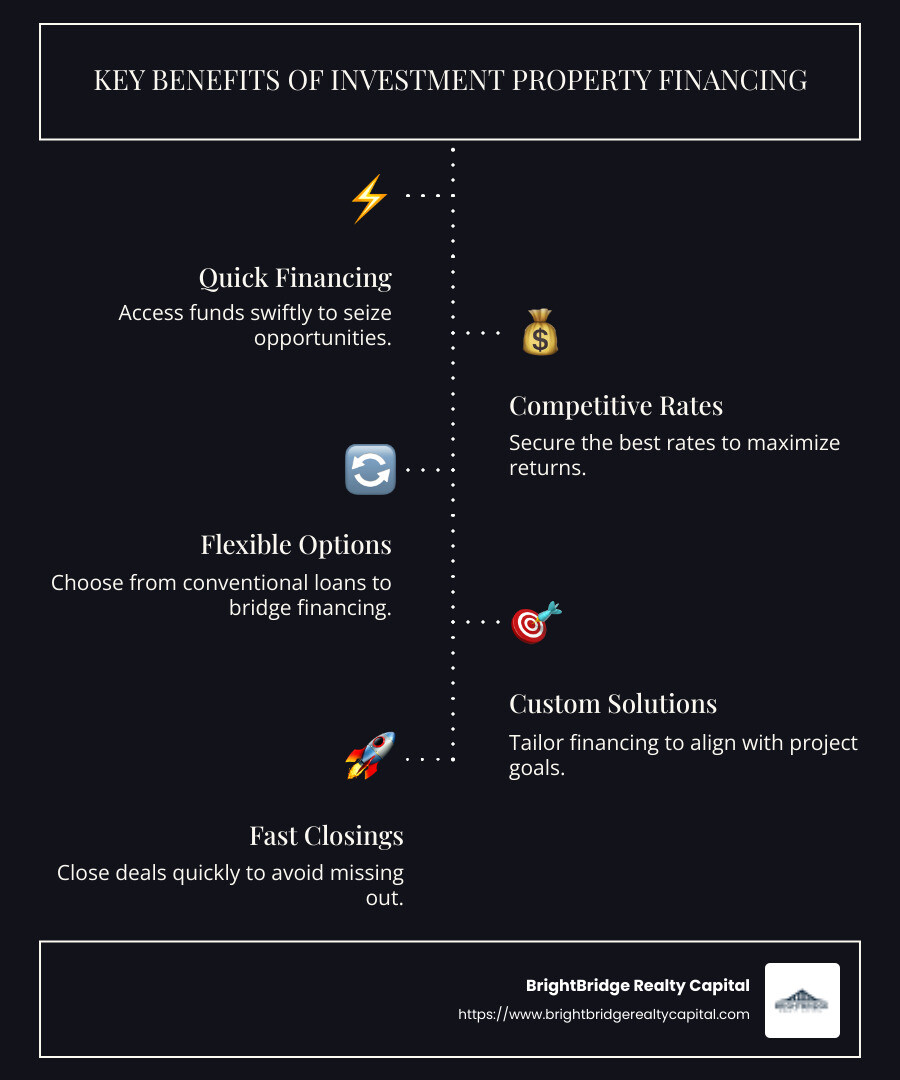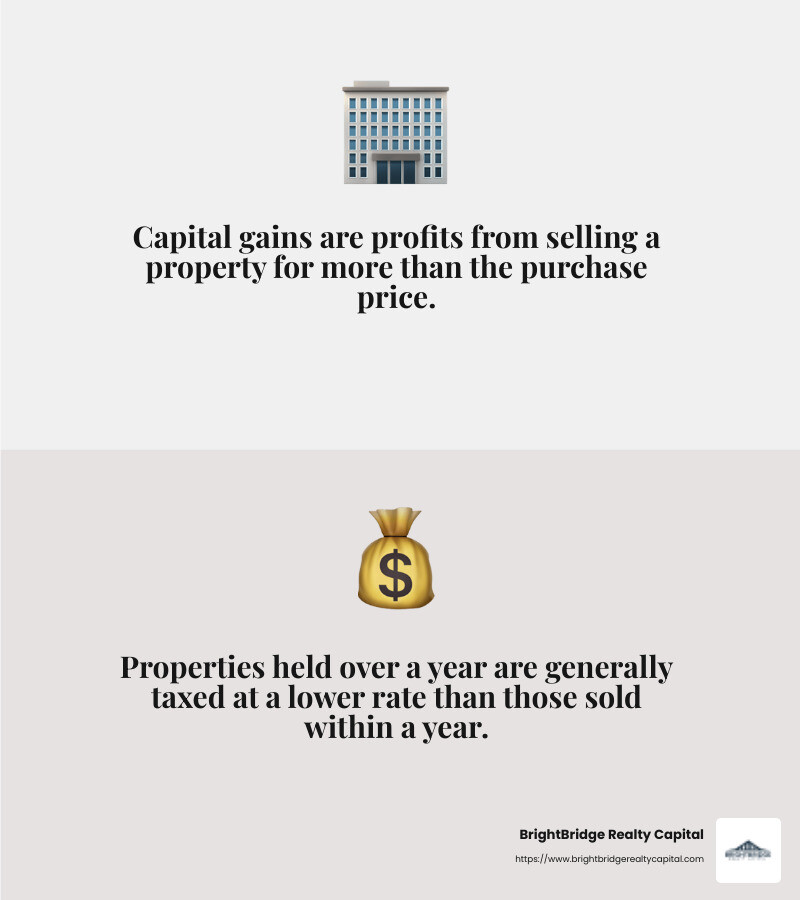Capital Ideas: Financing Your Investment Property

Investment property capital is crucial for anyone looking to expand their real estate portfolio. Whether you're eyeing a fix-and-flip project or wanting to grow your rental assets, having quick and flexible financing options is key to taking advantage of new opportunities without the headaches of slow and demanding loan processes.
- Quick, flexible financing: Necessary to seize investment opportunities.
- Find competitive rates: Save money and maximize returns.
- Fast closings: Ensure you don't miss out on lucrative deals.
Investment properties offer a unique gateway to not just add passive income but also to potentially see property value appreciation over time. Navigating through financing options can be daunting, especially with numerous choices, from conventional loans to bridge financing. But customizing a strategic capital solution that suits your project goals can transform what looks like a financial challenge into an opportunity.
By understanding the array of financing options available, real estate investors can position themselves to succeed in a competitive market. Here's what you need to know to effectively finance your investment property.

Common Investment property capital vocab:
Understanding Investment Property Capital
Investment property capital is the lifeblood of real estate investments. It’s the money you use to buy, maintain, and improve properties with the expectation of earning a return. This return can come from rental income, the future resale of the property, or both.
Capital Gains and Real Estate Investments
When you sell an investment property for more than you paid, the profit is called a capital gain. This is a key aspect of real estate investments, as capital gains can significantly boost your returns. However, they also come with tax implications, which can eat into your profits.
Capital gains taxes are triggered when you sell your property. These taxes can vary depending on how long you’ve held the property and your income level. Generally, properties held for more than a year are taxed at a lower rate than those sold within a year.

The Role of Investment Property Capital
Investment property capital is not just about buying properties. It's about strategically using your funds to maximize returns. This can involve:
- Renovations and improvements: Enhancing the property's value.
- Strategic acquisitions: Buying in areas with growth potential.
- Diversification: Spreading investments across different property types to reduce risk.
For instance, an investor might purchase a multifamily property, renovate it to increase its value, and then sell it at a higher price. Alternatively, they might hold onto the property, enjoying rental income and potential appreciation over time.
Navigating the Complexities of Real Estate Financing
Real estate investing can be complex, but understanding investment property capital can simplify it. By knowing how to leverage capital effectively, investors can make informed decisions that align with their financial goals.
- Evaluate financing options: Choose between loans, joint ventures, or other funding sources.
- Understand market trends: Stay informed about property values and rental rates.
- Plan for taxes: Consider strategies to minimize capital gains tax, like the 1031 exchange.
By mastering these elements, you can turn your real estate investments into a profitable venture, paving the way for long-term financial success.
Next, we'll dig into the various financing options available for investment properties, helping you choose the best path for your unique situation.
Financing Options for Investment Properties
When it comes to financing your investment property, there are several strategies you can employ. Each option has its pros and cons, and the best choice depends on your specific goals and financial situation.
Types of Financing
Traditional Bank Loans: These are what most people think of when it comes to financing. They typically offer lower interest rates but require a strong credit score and a significant down payment.
Bridge Financing: Ideal for short-term needs, bridge loans provide quick cash flow to secure a property or complete renovations. They usually have higher interest rates and are meant to be temporary solutions.
Construction Loans: For those looking to build from the ground up or undertake major renovations, construction loans provide the necessary funds. These loans are often structured to release money in stages as the project progresses.
SBA and USDA Loans: These government-backed loans are great for owner-user properties, offering favorable terms for those who qualify.
Joint Venture Capital: Partner with other investors to pool resources and share risk. This can be an effective way to finance larger projects.
Mezzanine Financing: This hybrid of debt and equity financing can fill the gap between what you can borrow from a bank and what you need to close a deal.
Strategic Capital Solutions
At BrightBridge Realty Capital, we understand that every investment is unique. That's why we offer strategic capital solutions custom to your needs:
- Non-recourse Loans: Protect your personal assets by securing loans that don't hold you personally liable.
- Preferred Equity: Gain priority in the capital stack, ensuring you receive returns before other equity investors.
- PACE Financing: Ideal for energy-efficient improvements, this financing option can help you improve your property's value while reducing utility costs.
Real Estate Financing: A Customized Approach
Real estate financing isn't one-size-fits-all. It's about finding the right mix of funding sources to match your investment strategy. Here are some tips to consider:
- Assess Your Risk Tolerance: Higher risk can mean higher reward, but understand your comfort level.
- Understand the Market: Research property types and locations to identify where your investment will yield the best returns.
- Plan for the Long Term: Consider how each financing option affects your cash flow and potential tax implications.
By exploring these financing options and working with a knowledgeable partner like BrightBridge Realty Capital, you can secure the capital you need to grow your investment portfolio effectively.
Next, we’ll look into calculating returns on investment properties, focusing on measuring profitability through ROI, capitalization rate, and cash flow.
Calculating Returns on Investment Properties
When investing in real estate, understanding how to calculate returns is crucial. Let's break down the key metrics: ROI, capitalization rate, and cash flow.
Return on Investment (ROI)
ROI measures the efficiency of your investment. It's a simple way to see how much profit you're making relative to the cost of the investment. Here's how you calculate it:
[ \text{ROI} = \left( \frac{\text{Net Profit}}{\text{Total Investment Cost}} \right) \times 100 ]
For example, if you bought a property for $200,000 and later sold it for $300,000, your net profit is $100,000. Your ROI would be 50%.
Capitalization Rate
The capitalization rate, or cap rate, is another way to gauge an investment property's profitability. It tells you the expected rate of return based on the property's net operating income (NOI).
[ \text{Cap Rate} = \left( \frac{\text{NOI}}{\text{Current Market Value}} \right) \times 100 ]
A cap rate between 4% and 10% is typical, but the right rate depends on your risk tolerance and market conditions. A higher cap rate often indicates more risk but potentially more reward.

Cash Flow
Cash flow is all about the money left after paying all expenses, including mortgage payments, taxes, and maintenance. Positive cash flow means your property is generating more income than it costs to own it.
To calculate cash flow:
[ \text{Cash Flow} = \text{Total Rental Income} - (\text{Operating Expenses} + \text{Debt Payments}) ]
Consistent positive cash flow is a sign of a healthy investment. It can also help you weather market downturns or unexpected expenses.
Putting It All Together
By analyzing these metrics, you can get a comprehensive view of your investment's performance. ROI gives you a broad view of profitability, while the cap rate helps with quick comparisons. Cash flow ensures you're not just profitable on paper but also have money coming in regularly.
Understanding these calculations can help you make informed decisions about buying, holding, or selling properties. Next, we'll explore strategies to minimize capital gains tax, helping you keep more of your profits.
Strategies to Minimize Capital Gains Tax
When you sell an investment property, capital gains tax can take a big chunk out of your profits. But don't worry, there are strategies to help you minimize this tax burden.
1031 Exchange
A 1031 exchange is a powerful tool for deferring capital gains tax. This strategy allows you to swap one investment property for another of like-kind without paying taxes immediately. The key is to reinvest the proceeds from your sale into a new property.
Here’s how it works:
- Identify a new property within 45 days of selling your old one.
- Complete the purchase of the new property within 180 days.
By doing this, you defer the capital gains tax until you sell the new property. This doesn't eliminate the tax, it just postpones it.
Tax-Loss Harvesting
Tax-loss harvesting is another smart move. This involves selling investments that are underperforming at a loss to offset your gains.
For example, if you made a $100,000 profit on a property sale but lost $75,000 on stocks, you can subtract the loss from the gain. This reduces your taxable gain to $25,000, saving you a significant amount in taxes.
Qualified Opportunity Funds
Investing in Qualified Opportunity Funds (QOFs) is another way to defer capital gains. These funds invest in economically distressed areas, known as Opportunity Zones. By reinvesting your gains into a QOF, you can defer taxes until 2026 or until you sell your QOF investment, whichever comes first.
Benefits include:
- A 10% increase in basis if you hold the investment for at least 5 years.
- An additional 5% increase if held for 7 years.
- If held for over 10 years, you can sell the QOF investment without paying taxes on any appreciation.
Converting to a Primary Residence
Another strategy is to convert your investment property into your primary residence. By living in the property for at least two years, you may qualify for a capital gains exclusion. This exclusion allows you to exclude up to $250,000 of capital gains from taxes if you're single, or $500,000 if married filing jointly.
These strategies can significantly reduce your tax burden, keeping more money in your pocket. Next, we'll address frequently asked questions about investment property capital, helping you make informed decisions.
Frequently Asked Questions about Investment Property Capital
What is a good ROI on rental property?
When it comes to rental properties, a good Return on Investment (ROI) is crucial. Generally, investors look for an ROI of at least 8% to 12%. This means for every dollar you invest, you should aim to get at least 8 to 12 cents back as profit per year.
To calculate ROI, you need to consider factors like annual rental income, property expenses, and the total investment amount. Here's a simple formula:
ROI (%) = (Net Profit / Total Investment) x 100
For example, if you earn $12,000 in profit on a $100,000 investment, your ROI would be 12%.
How can I avoid capital gains tax on investment property?
Avoiding capital gains tax is a key concern for many property investors. Luckily, there are strategies to help you manage or defer these taxes:
- 1031 Exchange: Swap your investment property for another of like-kind to defer taxes.
- Tax-Loss Harvesting: Offset gains by selling underperforming investments at a loss.
- Qualified Opportunity Funds: Invest in these funds to defer taxes and potentially benefit from tax incentives.
Each of these strategies has its own rules and timelines, so it's wise to consult with a tax professional to choose the best option for your situation.
Can I afford an investment property?
Affordability is a major factor when considering an investment property. Start by evaluating your financial health:
- Credit Score: A higher score can get you better loan terms.
- Down Payment: Aim for at least 20% to 25% of the property's price.
- Debt-to-Income Ratio: Lenders prefer a ratio below 36%.
Additionally, consider the ongoing costs like maintenance, property taxes, and insurance. Use these insights to create a budget and see if investing in property fits your financial goals.
Understanding these factors will help you make informed decisions about investment property capital. With the right approach, you can maximize your returns and minimize tax burdens. Up next, we'll dive into customized financing solutions offered by BrightBridge Realty Capital.
Conclusion
At BrightBridge Realty Capital, we specialize in providing customized financing solutions custom to meet the unique needs of real estate investors. Whether you're looking to expand your rental portfolio, start on a fix-and-flip project, or invest in new developments, we offer a range of flexible funding options designed to keep your investment strategy on track.
One of our standout features is our ability to offer fast closings, often within a week. This speed can be crucial in the competitive real estate market, allowing you to seize opportunities as they arise without delay. Our direct lending approach eliminates intermediaries, ensuring you receive competitive rates and a seamless process from start to finish.
We understand that every investor's journey is different, and that's why we offer personalized guidance and support throughout the financing process. Our team of experts is dedicated to helping you steer the complexities of real estate financing, ensuring you have the best tools and resources at your disposal.
For those interested in learning more about how we can assist with your investment property capital needs, we invite you to explore our services and see how we can help you achieve your real estate goals.
Find more about our customized financing solutions and fast closings at BrightBridge Realty Capital.


